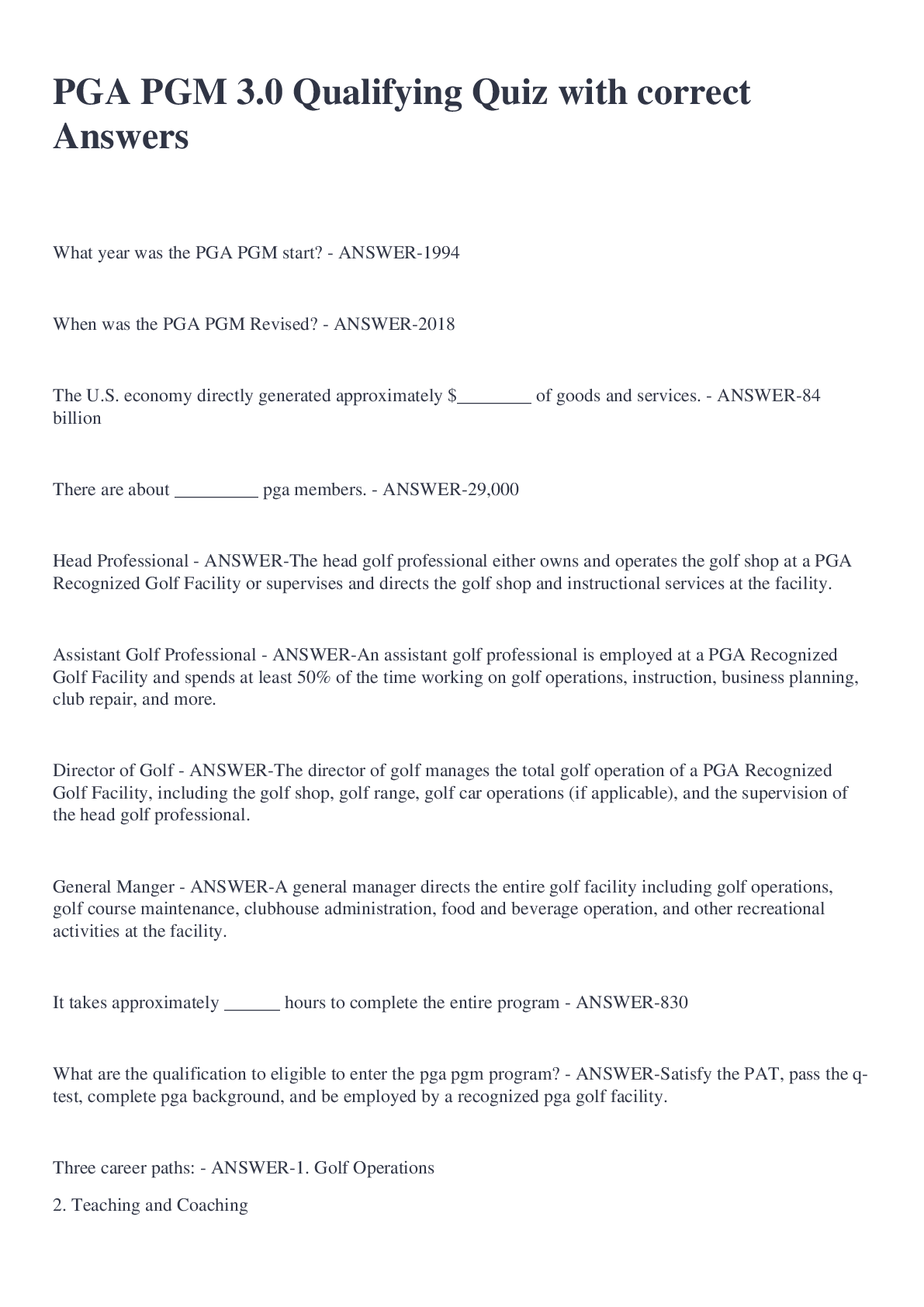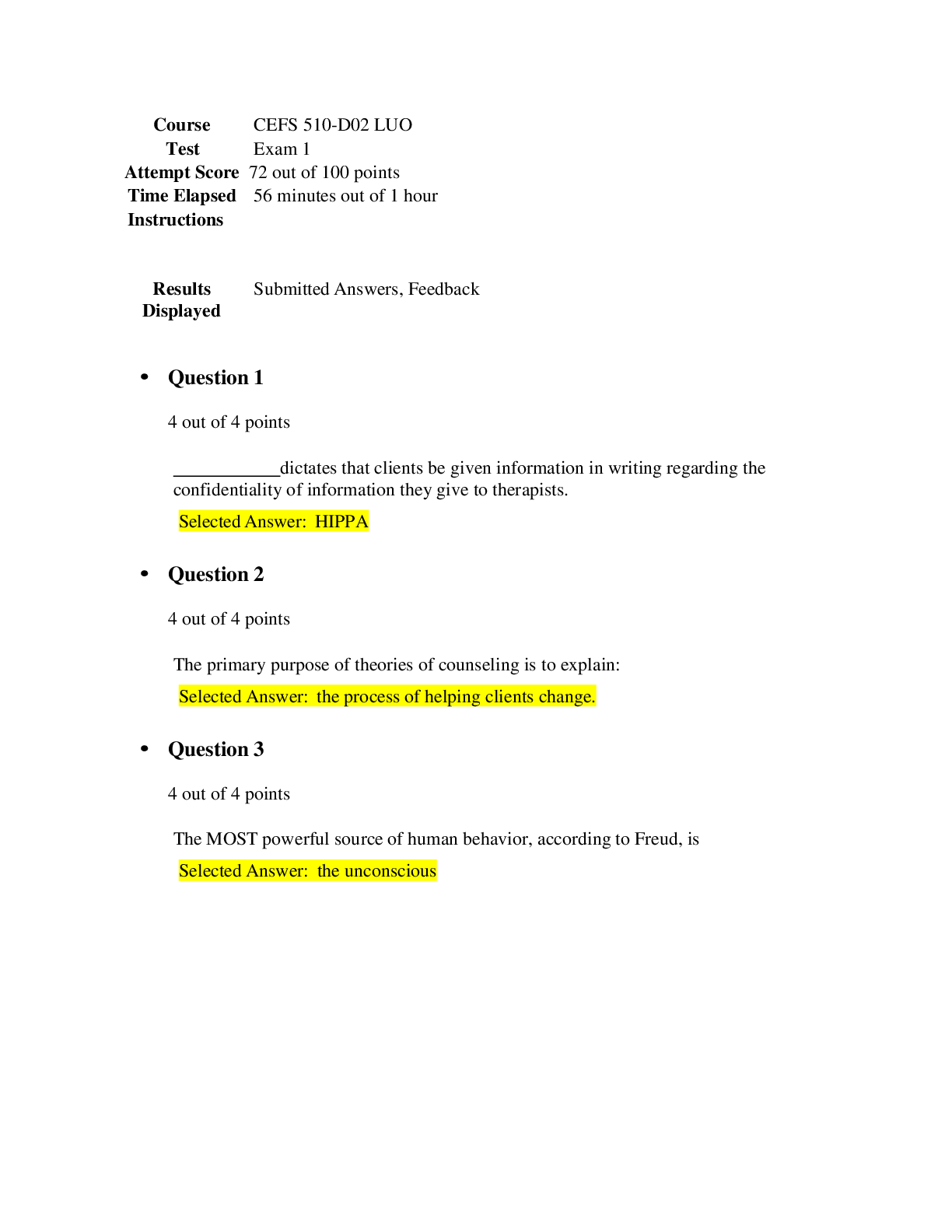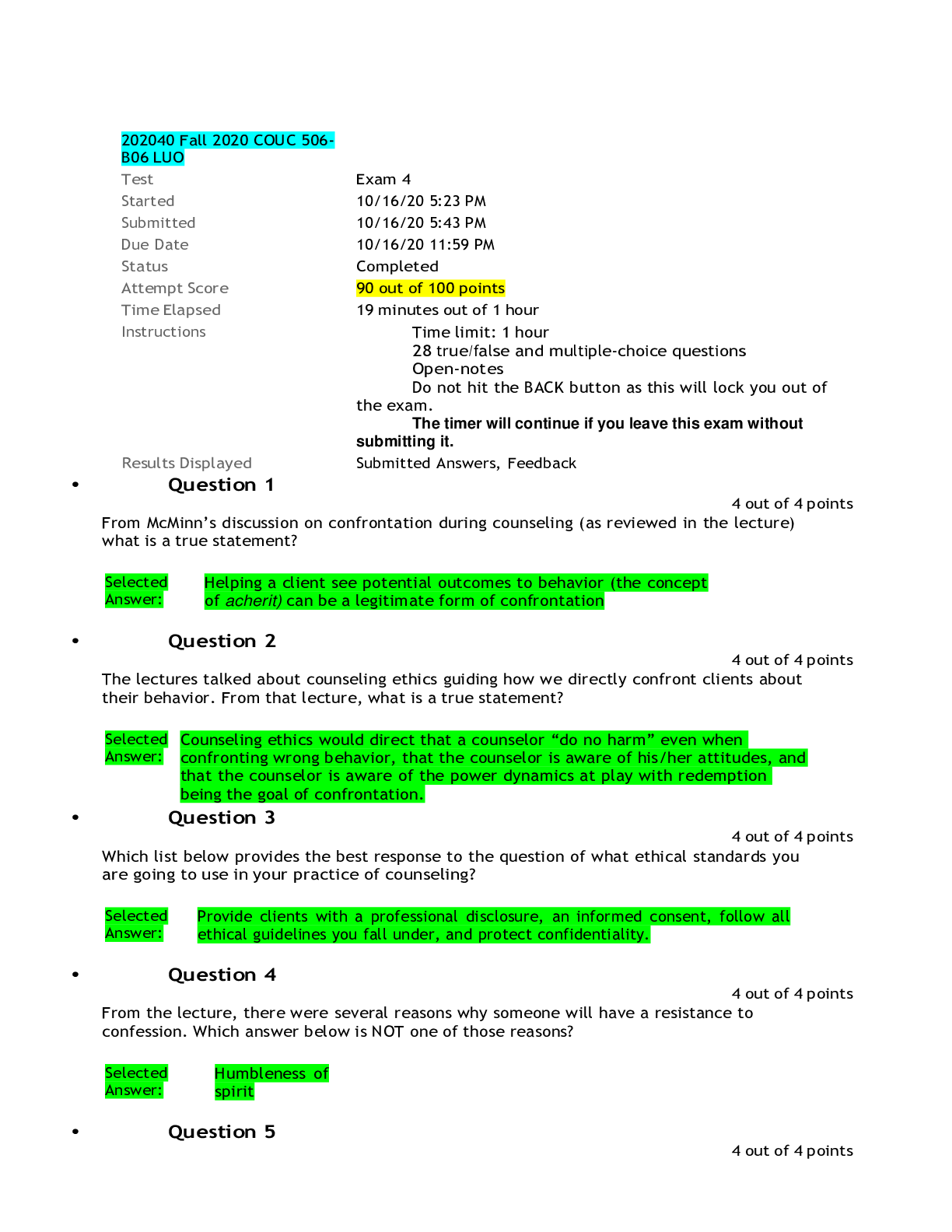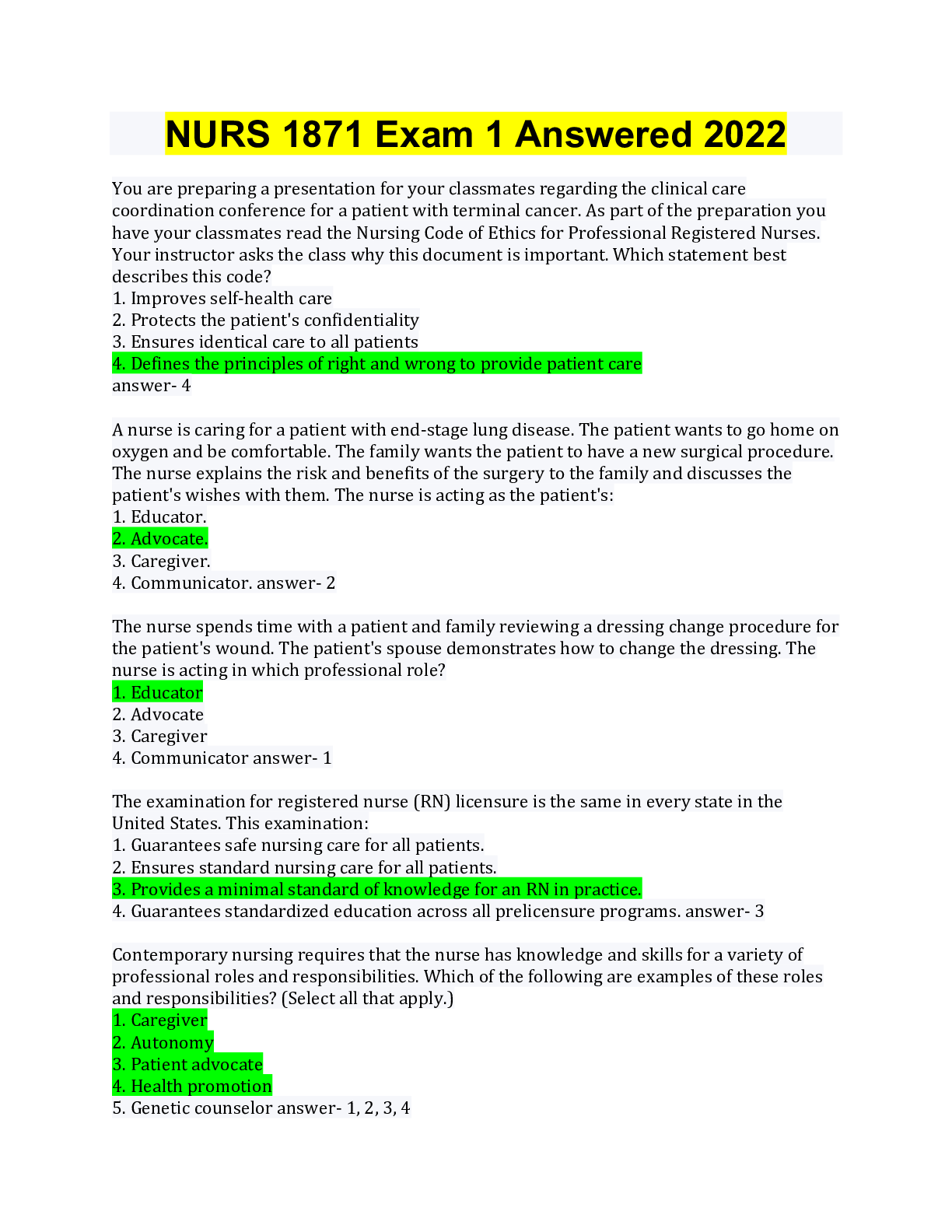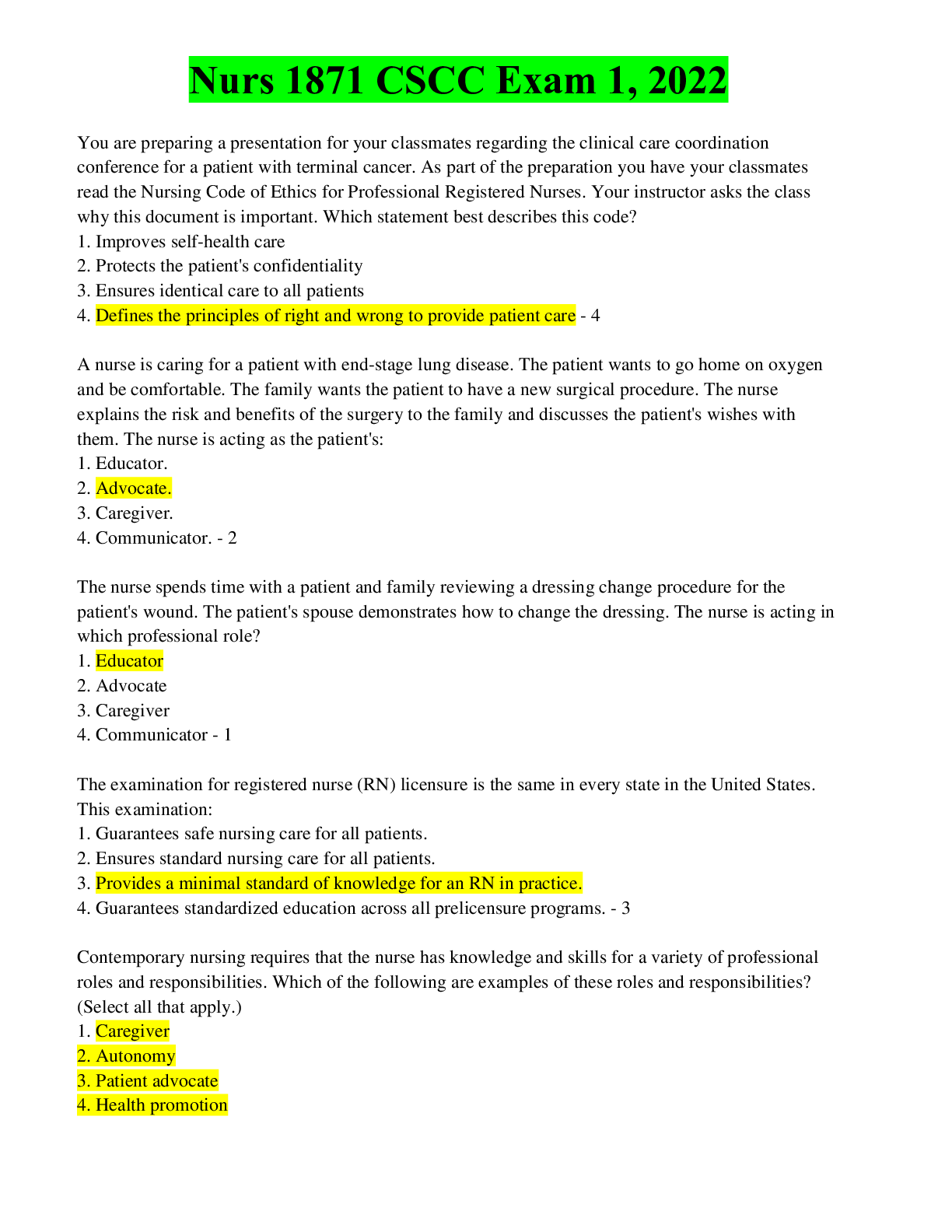Pathophysiology > EXAM > Rasmussen Patho Exam 1 (Answered) (All)
Rasmussen Patho Exam 1 (Answered)
Document Content and Description Below
Pathophysiology - ANSWER the study of how disease processes affect the function of the body sign vs symptom - ANSWER a sign is a physical manifestation (objective), a symptom is what the patient te... lls you about the disease (subjective) Cell components - ANSWER nucleus/nucleolus, cytoplasm, cell membrane General Adaptation Syndrome (GAS) - ANSWER the body's adaptive response to stress in three phases—alarm, resistance, exhaustion. Intracellular fluid (ICF) - ANSWER fluid inside cells Extracellular fluid (ECF) - ANSWER fluid outside the cells; includes intravascular and interstitial fluids intravascular fluid - ANSWER fluid within blood vessels interstitial fluid - ANSWER liquid found between the cells of the body that provides much of the liquid environment of the body edema - ANSWER Abnormal accumulation of fluid in interstitial spaces of tissues. Fluid Volume Deficit (FVD) - ANSWER (hypovolemia) loss of both water and electrolytes in similar proportions from the ECF fluid overload - ANSWER a condition that occurs when the body cannot handle the amount of fluid consumed Hypervolemia - ANSWER abnormal increase in the volume of blood plasma in the body RAAS (renin-angiotensin-aldosterone system) - ANSWER Maintain blood pressure; Renin is released by kidneys in response to decreased blood volume; causes angiotensinogen to split & produce angiotensin I; lungs convert angiotensin I to angiotensin II; angiotensin II stimulates adrenal gland to release aldosterone & causes an increase in peripheral vasoconstriction Sodium value: - ANSWER 135-145 mEq/L Hypernatremia - ANSWER increased sodium levels; thirst, muscle twitching, hyper flex is, seizure Hyponatremia - ANSWER 1. Headache 2. Seizure 3. Coma Potassium value - ANSWER 3.5-5.0 mEq/L Hypokalemia S/S - ANSWER Fatigue, Anorexia, N/V, Muscle weakness, Decreased GI motility, Dysrhythmias, Paresthesia, Flat T waves on ECG Hyperkalemia S/S - ANSWER Muscle weakness, Bradycardia, Dysrhythmias, Faccid paralysis, Intestinal colic, Tall T waves on ECG Calcium value - ANSWER 9.0-10.5 mg/dL Hypercalcemia S/S - ANSWER Muscle weakness, Constipation, Anorexia, N/V, Polyuria, Polydipsia, Neurosis, Dysrhythmias, Hypocalcemia S/S - ANSWER Diarrhea, Numbness, Tingling of extremities and around mouth, Convulsions, Positive Chvostek sign, Positive Trousseau sign, *Pt at risk for tetany. Magnesium values - ANSWER 1.5-2.5 mEq/L Hypomagnesemia S/S - ANSWER Anorexia, Distention, Neuromuscular irritability, Depression, Disorientation Hypermagnesemia S/S - ANSWER Flushing, Hypotension, Drowsiness, Lethargy, Hypoactive reflexes, Depressed respirations, Bradycardia Phosphate values - ANSWER 2.4-4.4 mg/dL Hypophosphatemia symptoms - ANSWER CNS depression, confusion, muscle weakness and pain, dysrhythmias, cardiomyopathy Hyperphosphatemia symptoms - ANSWER Hypocalcemia• Hyperparathyroidism• Renal osteodystrophy• Ectopic Calcification Cardinal signs of inflammation - ANSWER redness, swelling, heat, pain, loss of function Inflammatory response process - ANSWER Tissue damage-vasodilatation-edema-heat-redness-pain Hypersensitivity - ANSWER an exaggerated response by the immune system to a particular substance Type 1 hypersensitivity - ANSWER IgE; allergens, anaphylaxis, asthma Type 2 hypersensitivity - ANSWER cytotoxic, IgG/IgM (erythroblastosis) Type 3 hypersensitivity - ANSWER immune complex; rheumatoid arthritis, lupus Type 4 hypersensitivity - ANSWER Delayed cell mediated; transplant, TB test (takes a few days) Immunosupression - ANSWER reduction in the activity of the body's immune system HIV/AIDS - ANSWER Virus that destroys the immune system that should protect the body from diseases. The disease is passed from person to person through sexual acts, blood transfusions, used hypodermic needles, or from mother to child during birth. Cancer - ANSWER disorder in which some of the body's cells lose the ability to control growth Benign - ANSWER mild, not cancerous; slow progress malignant - ANSWER cancerous; fast spreading, rapid, fatal Carcinogenesis - ANSWER development of cancer, initiation, promotion, progression Verrucae (warts) - ANSWER small, hard skin lesions caused by the human papillomavirus Herpes Simplex Virus (HSV) - ANSWER viral infection characterized by clusters of small vesicles filled with clear fluid on raised inflammatory bases on the skin or mucosa herpes zoster (shingles) - ANSWER painful eruption of vesicles that follows a nerve root on one side of the body Tineas (ringworm) - ANSWER Superficial fungal infection; circular, erythematous, pruritus, burning Candidasis - ANSWER Fungi known as candida albicans which can be found on the mouth, vagina etc of an infected person -Also known as a yeast infection, thrush Impetigo - ANSWER bacterial inflammatory skin disease characterized by vesicles, pustules, and crusted-over lesions; staphylococcus Lupus - ANSWER when immune system attacks tissues causing redness, pain, swelling, and damage; butterfly rash Psoriasis - ANSWER chronic, recurrent dermatosis marked by itchy, scaly, red plaques covered by silvery gray scales; *psoriatic arthritis Atopic Dermatitis (Eczema) - ANSWER chronic inflammation of the skin; rash occurs in face, neck , elbows, knees, and upper trunk of the body along with itching Scabies - ANSWER contagious, parasitic infection of the skin with intense pruritus Ticks - ANSWER small gray-brown parasites that bite into tissue and suck blood and transmit several diseases to people, in particular Rocky Mountain spotted fever, Lyme disease, and Tularemia. Impetigo treatment - ANSWER antibiotics Shingles treatment - ANSWER antiviral, pain medication tineas treatment - ANSWER lamisil (terbinafine-HCl cream ... topical); shampoo containing selenium; ketoconazole or itraconazole for initial antimicrobial agent therapy; griseofulvin (oral) for chronic infections Candidiasis treatment - ANSWER Topical and oral anti-fungal drugs Herpes simplex treatment - ANSWER topical acyclovir oral acyclovir valacyclovir famicyclovir Psoriasis treatment - ANSWER Phototherpay, laser theray, MTX, Immunomodulators (Enbrel) atopic dermatitis treatment - ANSWER -Avoid triggers -Moisturizing/non-allergen soap (eg; dove white) -Moisturizers, eg: petrolatum, Aquaphor ointment (not lotion) -Corticosteroid cream on/off with lesions, if above is ineffective Eg: Triamcinolone 0.1% cream; Sig: apply to affected area bid, PRN for exacerbations. Scabies treatment - ANSWER permethrin cream 1st degree burn - ANSWER Only the epidermis (red, painful, and edema) 2nd degree burn - ANSWER epidermis and part of dermis (blistered) 3rd degree burn - ANSWER Full thickness damage through skin into nerves and muscles Burn complications - ANSWER -*hypovolemic shock* ( phase 1 ) -fluid resuscitation -*infection* ( phase 2 & 3 ) -*contractures* -inhalation injury -scarring -*curling's ulcer* -heart & renal failure -*paralytic ileus* Skin cancer - ANSWER abnormal growth of skin cells basal cell carcinoma - ANSWER malignant tumor of the basal cell layer of the epidermis squamous cell carcinoma - ANSWER a type of rapidly growing cancer that appears as a scaly, reddened patch of skin Melanoma - ANSWER The most serious form of skin cancer Degenerative Joint Disease (Osteoarthritis) - ANSWER Progressive degeneration of articular cartilage; most common type of arthritis; overuse Osteomyelitis - ANSWER infection of the bone tissue Osteosarcoma - ANSWER bone cancer Rickets - ANSWER osteomalacia in children; causes bone deformity; vitamin d deficient Osteomalacia/rickets - ANSWER bones become softer because of a vitamin D deficiency Types of fractures - ANSWER Simple-transverse, spiral, oblique, compound, comminuted, greenstick, open, closed, compression, incomplete, stress, pathophysiological, impacted compartment syndrome - ANSWER injury caused when tissues such as blood vessels and nerves are constricted within a space as from swelling or from a tight dressing or cast Compartment syndrome treatment - ANSWER Fasciotomy: Incision through skin and subcutaneous tissue and fascia of affected compartment, relieves pressure and restores circulation Compartment Syndrome S/S - ANSWER Pain, Passive stretch(w/hyperextension), Paresthesia, Pallor, Absent/diminished pulses rheumatoid arthritis (RA) - ANSWER chronic joint condition with inflammation and pain; caused by an autoimmune reaction against joint tissue, particularly the synovial membrane Osteoarthritis (OA) - ANSWER progressive, degenerative joint disease with loss of articular cartilage and hypertrophy of bone (formation of osteophytes, or bone spurs) at articular surfaces Psoriatic arthritis - ANSWER An inflammatory arthritis associated with psoriasis of the skin Psoriatic Arthritis treatment - ANSWER treatment may include medication to reduce inflammation, steroid injections, or joint replacement surgery Gout - ANSWER hereditary metabolic disease that is a form of acute arthritis, characterized by excessive uric acid in the blood and around the joints myasthenia gravis (MG) - ANSWER a chronic autoimmune disease that affects the neuromuscular junction and produces serious weakness of voluntary muscles Fibromyalgia - ANSWER chronic condition with widespread aching and pain in the muscles and fibrous soft tissue muscular dystrophy - ANSWER group of hereditary diseases characterized by degeneration of muscle and weakness Sprain - ANSWER An injury in which the ligaments holding bones together are stretched too far and tear. Strain - ANSWER A condition resulting from damaging a muscle or tendon [Show More]
Last updated: 1 year ago
Preview 1 out of 7 pages
Instant download

Buy this document to get the full access instantly
Instant Download Access after purchase
Add to cartInstant download
Reviews( 0 )
Document information
Connected school, study & course
About the document
Uploaded On
Sep 20, 2022
Number of pages
7
Written in
Additional information
This document has been written for:
Uploaded
Sep 20, 2022
Downloads
0
Views
30



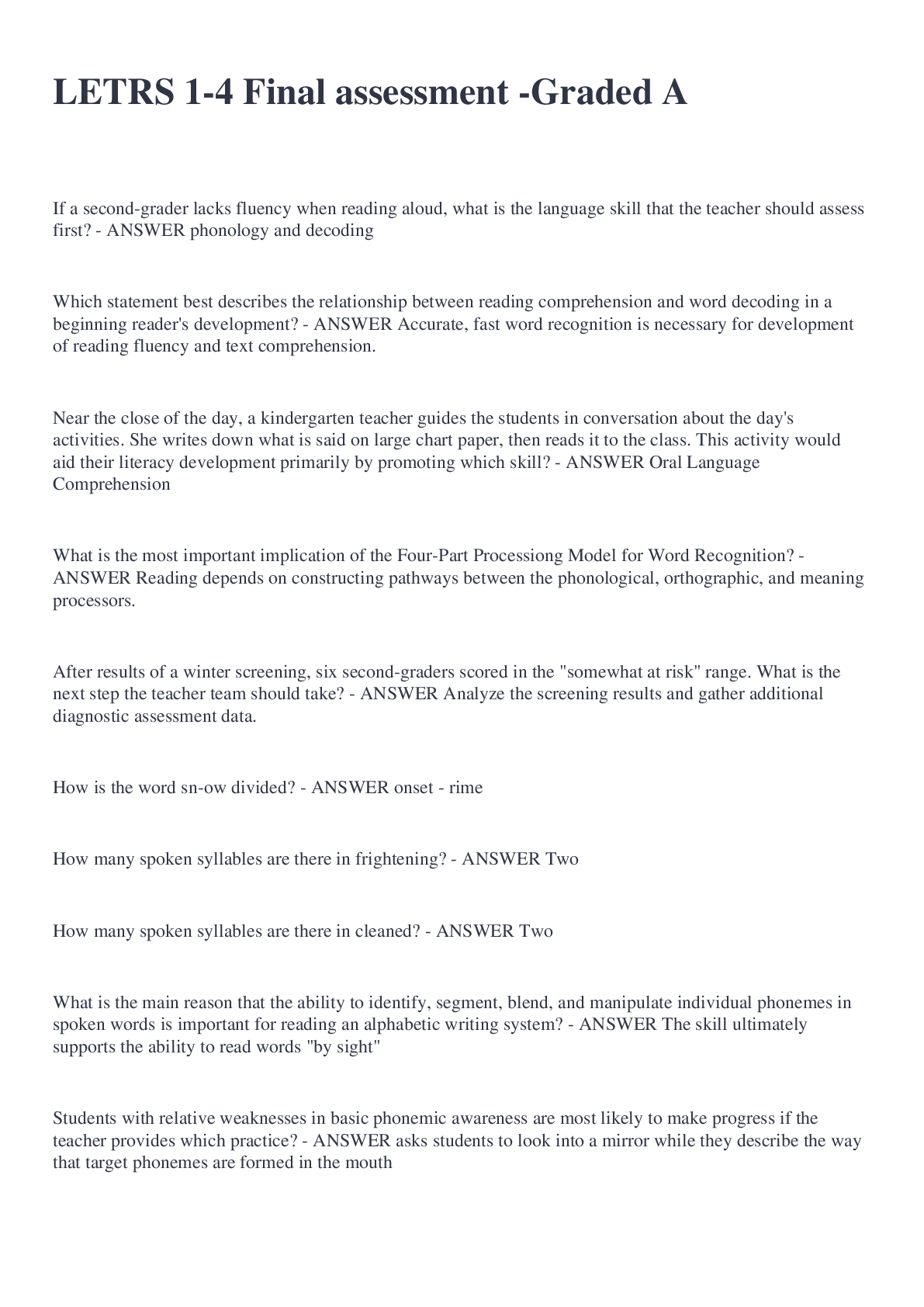


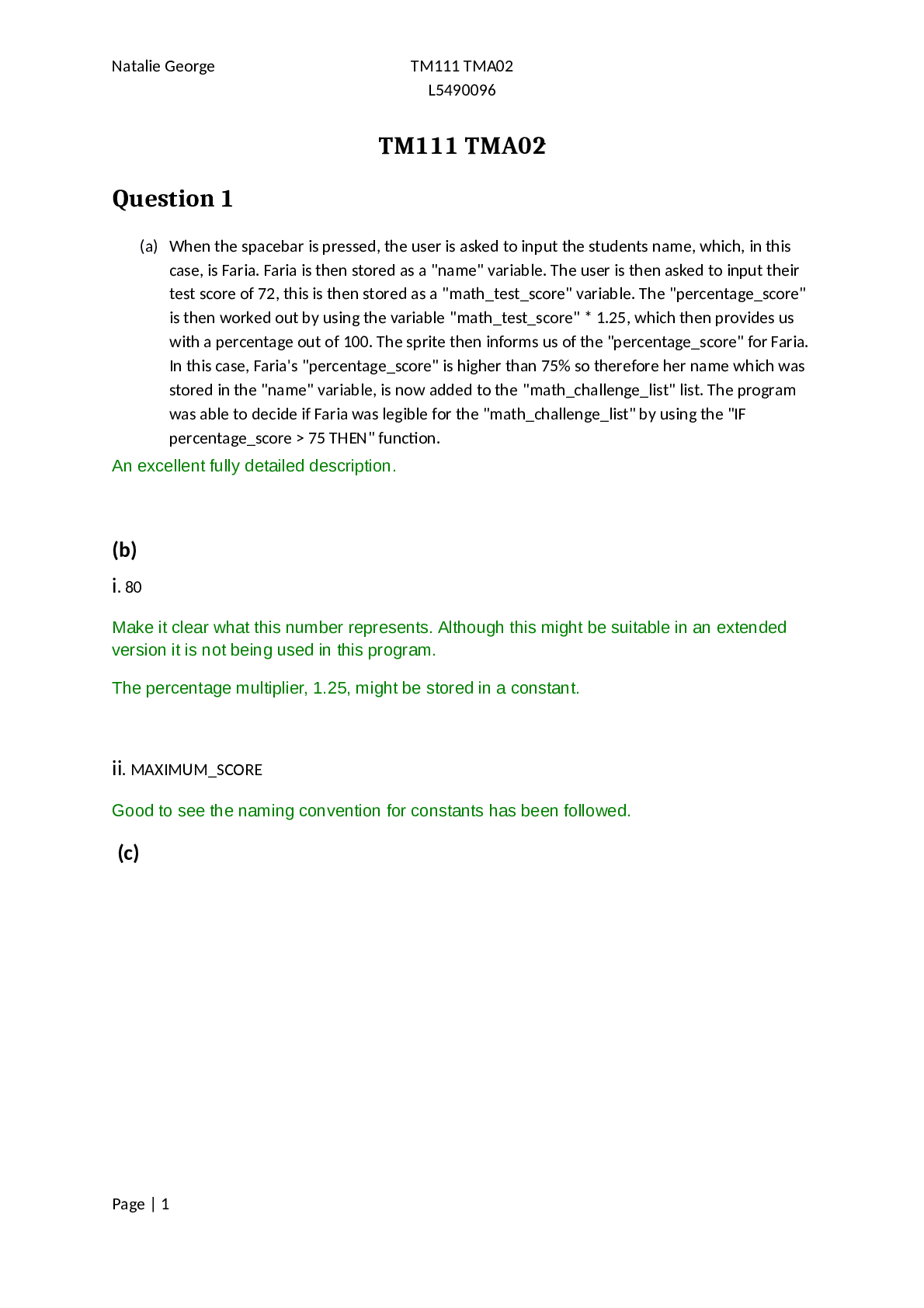


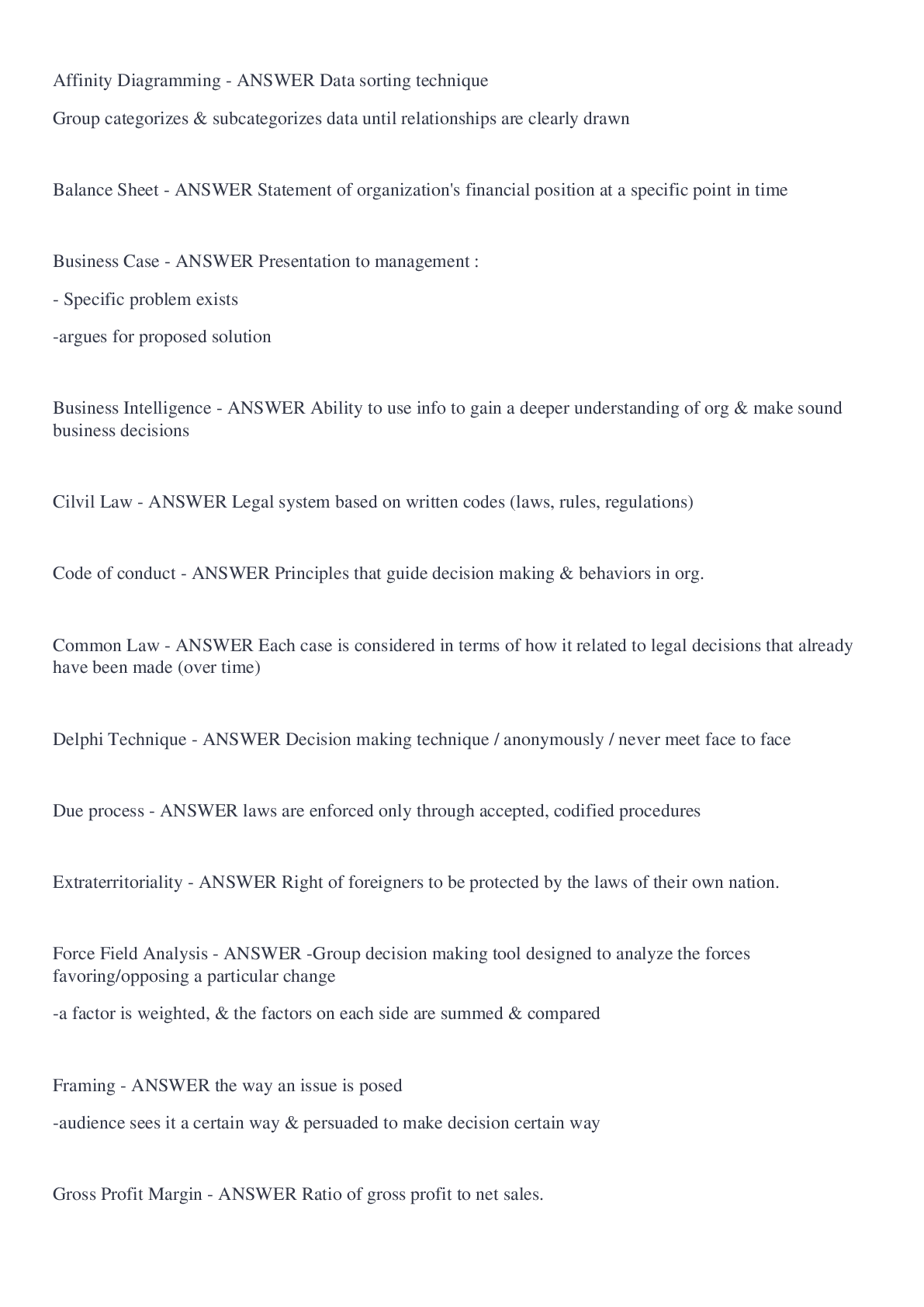

.png)
